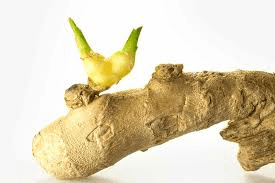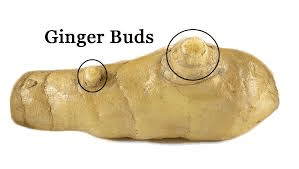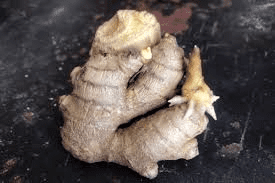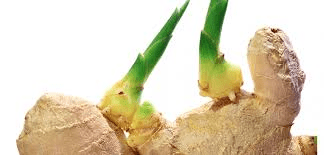Ginger eyes, also known as “ginger buds” or “ginger sprouts,” are the small, budding growth points found on the surface of the ginger rhizome (Zingiber officinale). These eyes are the starting points for new shoots and roots, indicating that the rhizome is viable and capable of growth. Understanding the role and characteristics of ginger eyes is essential for anyone interested in growing ginger or utilizing it in culinary and medicinal applications.
Ginger eyes are easily recognizable as small, slightly raised nodules on the surface of the rhizome. They can vary in color from pale yellow to green or even reddish, depending on the variety of ginger and its growing conditions. Each eye has the potential to develop into a new shoot and root system, enabling the propagation of the plant. When planted, these eyes will sprout, producing new ginger plants that will eventually form their own rhizomes, perpetuating the cycle of growth.
The process of growing ginger starts with selecting healthy, plump rhizomes with multiple eyes. These rhizomes are typically cut into smaller sections, each containing at least one or two eyes. The sections are then planted in well-drained, fertile soil with the eyes facing upwards. The soil should be kept moist but not waterlogged, and the planting area should receive partial shade. Over time, the eyes will sprout, giving rise to new ginger shoots that will grow into full plants.
Ginger eyes play a crucial role in the propagation of ginger, making them valuable for both commercial cultivation and home gardening. By understanding how to properly select and plant ginger eyes, growers can ensure a successful harvest. The ability of ginger eyes to regenerate the plant also makes ginger a sustainable crop, as a small piece of the rhizome can yield multiple new plants.
In addition to their role in cultivation, ginger eyes can also be used in culinary applications, although they are less commonly utilized in this way. When preparing ginger for cooking, the eyes are typically removed along with the skin. However, they are entirely edible and can be included in recipes that call for ginger, contributing the same pungent flavor and health benefits as the rest of the rhizome.
Medicinally, ginger eyes contain the same bioactive compounds found in the rest of the ginger rhizome, such as gingerols and shogaols. These compounds have potent anti-inflammatory, antioxidant, and digestive properties. Including ginger eyes in medicinal preparations, such as teas, tinctures, or extracts, can provide similar health benefits, aiding in digestion, reducing nausea, and supporting overall well-being.
Ginger eyes are small but vital components of the ginger rhizome, serving as the growth points for new shoots and roots. Their role in the propagation of ginger makes them essential for both large-scale cultivation and home gardening. While not typically highlighted in culinary uses, ginger eyes are edible and contain the same beneficial compounds as the rest of the rhizome. Understanding and utilizing ginger eyes can enhance the appreciation of this versatile and valuable plant, both in growing practices and in leveraging its health benefits.
The Economic Importance and Uses of Ginger Eyes

1. Propagation: Ginger eyes are the growing points or buds from which new ginger plants can develop. They are crucial for cultivating ginger crops.
2. Agricultural Value: Farmers use ginger eyes for planting new crops, ensuring a continuous supply of ginger.
3. Home Gardening: Home gardeners can use ginger eyes to grow ginger in their own gardens, providing a fresh supply for culinary and medicinal uses.
4. Crop Diversification: By using ginger eyes, farmers can diversify their crops and improve soil health, contributing to sustainable farming practices.
5. Genetic Conservation: Preserving ginger eyes helps in maintaining the genetic diversity of ginger plants, which is essential for breeding programs.
6. Organic Farming: Ginger eyes can be used in organic farming, as they do not require synthetic chemicals for propagation.
7. Economical Planting Material: Using ginger eyes as planting material is cost-effective for farmers compared to purchasing whole rhizomes.
8. Employment Generation: The cultivation and propagation of ginger using ginger eyes create employment opportunities in agriculture.
9. Research and Development: Ginger eyes are used in agricultural research to develop disease-resistant and high-yielding ginger varieties.
10. Climate Resilience: Propagating ginger using ginger eyes helps in developing crops that are resilient to changing climate conditions.
11. Export Potential: Countries that grow ginger can export ginger eyes as planting material to other regions, generating additional revenue.
12. Educational Use: Ginger eyes are used in educational programs to teach students about plant propagation and agriculture.
13. Biodynamic Farming: Ginger eyes can be incorporated into biodynamic farming practices, which focus on holistic and sustainable agricultural methods.
14. Culinary Use: In some culinary traditions, young ginger eyes are used as a delicacy and can be added to dishes for their unique flavor.
15. Herbal Remedies: Ginger eyes are sometimes used in traditional medicine for their potential health benefits, similar to ginger roots.
16. Sustainable Practices: Utilizing ginger eyes for propagation reduces waste, as even small parts of the ginger plant are used productively.
17. Rural Development: The cultivation of ginger using ginger eyes can contribute to rural development by improving agricultural productivity and income.
18. Soil Improvement: Planting ginger eyes can enhance soil structure and fertility, benefiting subsequent crops.
Read Also: Goat Milk Production Complete Guide
The Products and By-products That Can Be Derived From Ginger Eyes

1. Fresh Ginger Eyes: Used as planting material for growing new ginger plants.
2. Pickled Ginger Eyes: Young ginger eyes can be pickled and used as a condiment.
3. Ginger Eye Tea: Brewed from fresh ginger eyes for a mild, refreshing beverage.
4. Ginger Eye Extract: Extracted from ginger eyes and used in supplements and cosmetics.
5. Ginger Eye Paste: Made by grinding fresh ginger eyes into a paste, used in cooking.
6. Ginger Eye Powder: Dried and ground ginger eyes used as a spice.
7. Ginger Eye Capsules: Encapsulated powdered ginger eyes used as a dietary supplement.
8. Ginger Eye Oil: Extracted through distillation for use in aromatherapy and cosmetics.
9. Ginger Eye Juice: Extracted from fresh ginger eyes and used in beverages and cooking.
10. Ginger Eye Vinegar: Produced by fermenting ginger eyes with vinegar, used in salads and marinades.
11. Ginger Eye Syrup: Made by boiling ginger eyes with sugar and water, used as a sweetener and flavoring.
12. Dried Ginger Eyes: Dried and used as a spice or snack.
13. Ginger Eye Shampoo: Shampoo containing ginger eye extract for its scalp-soothing properties.
14. Ginger Eye Soap: Soap infused with ginger eye extract for its skin benefits.
15. Ginger Eye Wine: An alcoholic beverage made by fermenting ginger eyes with sugar and yeast.
16. Fermented Ginger Eyes: Used in making fermented foods like kimchi and sauerkraut.
17. Ginger Eye Sauce: A savory sauce made from ginger eyes, used in cooking and as a condiment.
Read Also: Worm Infestation on Ruminant Animals: Symptoms and Treatment
Frequently Asked Questions (FAQ’s) About Ginger Eyes

1. What are ginger eyes?
Ginger eyes are the buds or growing points on ginger rhizomes from which new ginger plants develop.
2. How do you use ginger eyes for planting?
Cut the ginger rhizome into pieces, ensuring each piece has at least one eye, and plant them in soil.
3. Can ginger eyes be used in cooking?
Yes, young ginger eyes can be used in some culinary dishes for their mild flavor.
4. Are ginger eyes as nutritious as ginger roots?
Ginger eyes contain similar nutrients to ginger roots, though they are typically used for propagation rather than consumption.
5. How do you store ginger eyes before planting?
Store ginger eyes in a cool, dry place to prevent them from drying out or sprouting prematurely.
6. Can ginger eyes be used in traditional medicine?
Yes, ginger eyes are sometimes used in traditional remedies, similar to ginger roots.
7. How do you propagate ginger using ginger eyes?
Plant ginger eyes in well-drained soil, keep them moist, and they will sprout and grow into new plants.
8. Are ginger eyes suitable for organic farming?
Yes, ginger eyes can be used in organic farming as they do not require synthetic chemicals.
9. How long does it take for ginger eyes to sprout?
Ginger eyes typically take a few weeks to sprout after planting, depending on growing conditions.
10. What products can be made from ginger eyes?
Products include fresh ginger eyes, pickles, tea, extract, paste, powder, capsules, oil, juice, vinegar, syrup, dried eyes, shampoo, soap, wine, fermented foods, and sauce.

